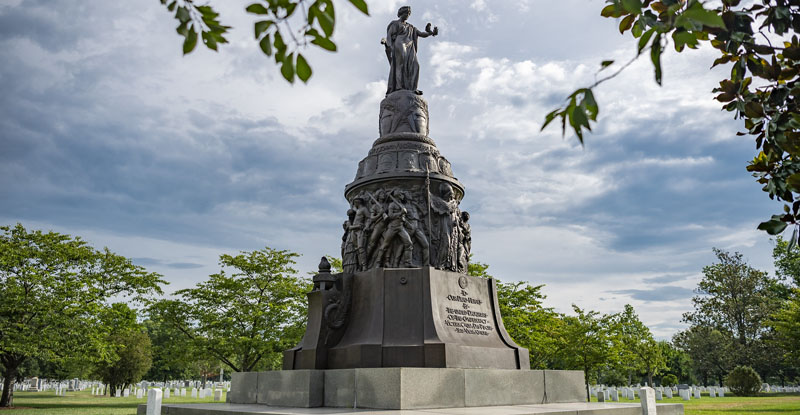By Lt. Col. William Layer, USAR ret
On September 2nd the Army closed its thirty-day comment period soliciting the public’s views for the disposition of the soon to be removed Confederate Memorial from Arlington Cemetery where it has stood, little noticed, for over a century.
By law, the memorial is to be torn down because it glorifies the Confederacy and “white supremacy”. Its removal was recommended by the Naming Commission whose mission is to eradicate any memory of the Confederacy on military installations.
Given the “woke” hatred for the South, however, was asking for public comment cover for the memorial’s destruction? “You can cut off a man’s head,” said Winston Churchill, “and still say you consulted him.”

Moses Jacob Ezekiel, VMI 1866
Unveiled in 1914 by President Woodrow Wilson, the memorial was created by the noted sculptor Moses Ezekiel, the first Jewish graduate of VMI.
Removing it is an insult to history and art, akin to ISIS’s destruction of Syria’s archeological heritage.
Contrary to the cemetery’s misleading plaque, Ezekiel’s monument does not “romanticize” the Confederacy, it shows soldiers departing for war; without inscriptions it could be a Union monument.
The most instantly recognizable racial image is of a Confederate officer entrusting the care of his young son to the family “mammy”, an expression of trust and affection, not racialism, nor “white supremacy”.
Slavery and segregation were abhorrent; I write not in defense of a romanticized South, but in defense of history.
I am not a Southerner; I am a New Yorker whose ancestors wore Union blue.
I oppose removing the memorial as I oppose the wanton destruction of Confederate statues by Talibanesque mobs.
These infantile Marxists and their “progressive” allies demand perpetual vengeance against the South, repudiating Lincoln’s vision of “binding up the nation’s wounds.”
Do not think, however, that their demands will stop with obliterating Confederate monuments.
During the BLM riots a mob wanted to pull down the statue of Lincoln freeing a slave in Washington’s Lincoln Park asserting that the statue, by depicting a black man on one knee before Lincoln, is racist. In fact, the sculpture was commissioned and financed by former slaves in gratitude for their emancipation, but that doesn’t matter, the woke seek not national comity but enmity.
To the left, Confederates are guilty of treason even if President Andrew Johnson’s 1868 pardon absolved them of that charge.
But if true, the founding fathers were guilty of treason for rebelling against George III. It was the American belief that King George had violated the covenant with his people that ignited the Revolution, the same idea that provoked the English Civil War and the Glorious Revolution.
It was historian Charles Beard who discerned the parallel between the American Revolution and the “War of the Southern Rebellion” as it is labeled in the National Archives. The South, like the thirteen colonies, moved to secession as it felt its liberty threatened.
At its beginning the nation was referred to in the plural, the United States “are,” with American’s primary loyalty to their state.
The Treaty of Paris had granted independence to the thirteen colonies individually, not collectively. When the Constitutional Convention met it was guided by the covenant theory, the constitution was to be a compact between the states and the federal government. Ratification documents from Virginia, New York, et. al. countenanced secession if the covenant was not honored.
James Madison, “Father of the Constitution,” rejected the notion that a seceding state could or should be suppressed.
Federalist lawyer William Rawle’s A View of the Constitution of the United States of America (1829) noted, “… states, … may wholly withdraw from the Union.”
Black conservative economist Walter Williams has written, “The U.S. Constitution would have never been ratified — and a union never created — if the people of those 13 “free sovereign and Independent States” did not believe that they had the right to secede.”
Of fealty [to the Union] Rawle wrote, “allegiance would necessarily cease on the dissolution of the society to which it is due.” When Southern officers resigned their commissions as their states seceded, they were no longer bound by their oath to the United States, hence could not betray it.
Routinely, the left accuses Southern memorials of inspiring Jim Crow segregation, of intimidating blacks as if radiating some mystical power. If intimidation was wanted, the KKK was far cheaper and effective than collecting pennies for expensive sculptures.
The real mechanism of segregation was exposed in C. Vann Woodward’s The Strange Career of Jim Crow (1955) and Kathleen L. Wolgemuth’s “Woodrow Wilson and Federal Segregation,” Journal of Negro History (April 1959).
Democratic Party progressives were segregations front line. The progressive Woodrow Wilson segregated the civil service and his Secretary of the Navy, Josephus Daniels, segregated the fleet.
(Irony is at work: Confederates were Democrats, by removing their effigies is the party trying to smother its own history?)
Slavery was not purely a Southern or white institution, blacks too owned slaves. Slavery existed in the North as well, albeit on a smaller scale.
Shall statues of General Grant, a slave owner, be torn down?
What of Southerners who supported secession but opposed slavery, or Northerners who opposed secession but supported slavery?
The real objective for progressives, however, is dismantling America, extirpating Confederate remembrance is just one item on their agenda.
—
Lt. Colonel William Layer, USAR (ret) served twenty-six years in the regular and reserve components of the US Army. He was civil military liaison for the 260th Military Police, DC National Guard, State Public Affairs Officer, Commander of the Public Affairs unit and a counter-drug intelligence analyst.
Transferring to the 352 Civil Affairs Command as monuments and archives officer, he became the Command Public Affairs Officer in Iraq as well as liaison to local Iraqi leaders and acting Secretary to the General Staff. He was instrumental in recovering photographic artifacts of the Iraqi Royal family while in Baghdad. He was wounded in action in an ambush in Feb. 2004 for which he was awarded the Purple Heart.
In his civilian career he worked primarily in Army Public Affairs and for the Air Force as historian to the presidential wing in the early Reagan administration and later for Air Force Legislative Liaison covering congressional hearings and assisting in preparing testimony for senior leaders.
His essays and reviews have appeared in the scholarly and popular press including Asian Affairs and the Washington Times. He is co-author, with Ali Wahab, of The Iraqi Royal Family, a Collection of Photographs Recovered from The Ruins of the Zuhur Palace, 2004.
A native New Yorker, he holds a BA with honors in history from Findlay College (Ohio) and an MA in history from The Ohio State University. He is a graduate of the US Army Command & General Staff College and was graduated with distinction US Naval War College with a MA in National Security and Strategic Studies.








Leave a Comment